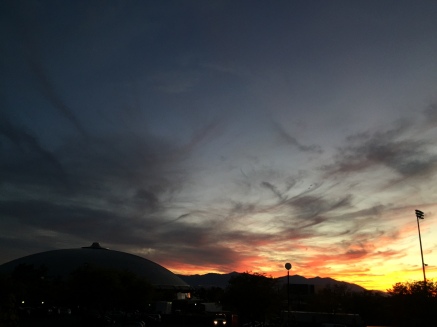Today my partner Courtney and I trekked through the cold and fresh snowfall from upper campus to the University of Utah Sustainability office. There we met with a woman named Ayrel, (pronounced Ariel,) to discuss our ideas for creating a visual pamphlet or map to show the Universities progress on converting lollipop lights and other light-pollution contributing fixtures to Night Sky Association-approved fixtures. We thought that this would be educational for students and staff, letting them see where our university stands and where we need to improve.
Ayrel liked our idea, but she did have some very helpful input that gave us new inspiration and ideas. She felt that our idea was educational, but not provocative. Since many of the students and staff on this university cannot do much to directly affect light pollution on our campus, she suggested that we provide a tangible means for individuals to impact light pollution in their own homes, businesses, etc. WHAT A GREAT IDEA!
From this, we (Courtney and I,) decided that we want to change our project back to an illustrated, easy to understand, informational poster that exposes the negative effects light pollution has on cities, the sky, other species, and our humanity. We are thinking of using posters because students may not want to pick up a pamphlet and read it. Whereas, a large poster that is plastered in largely trafficked areas will be easier to look at. This poster would also include animations and directions for people that would demonstrate ways to reduce light pollution in their own
Another idea Courtney and I have is to post small reminders/stickers in the bathrooms and classrooms around campus that remind students and staff to turn off lights if they are the last one in the room. This has already been done in the biology building on campus. Small, handmade neon signs in the bathrooms are posted on the door leading out of the restroom reminding people to shut the light off if they are the last one inside. It always reminds me to do so!
For my last update, I would like to share our status on applying transitional fixtures to the lollipop lights (in an attempt to reduce light pollution until funds are raised to replace them.)
Unfortunately, there are many reasons why this is not feasible. In our response from the Lighting Specialist Bill Leach, he detailed the reasons why using a transitional method would not work for us. Not only could using heat-resistant paint on the lights melt the acrylic fixtures, but the paint could potentially lead to premature lamp failure. Modifying a fixture might also degrade a light’s UL rating, which can leave the University liable for any injuries that might occur due to a fixture failure. Changing a light fixture also changes its photo-metrics, aesthetics, and efficiency. Adding an actual hood or hat onto the lamp would cause similar problems.
The good news is, these lollipop lights are expected to be changed within the next year! YAY!
That is all for today, more updates to come soon.
Ashley



